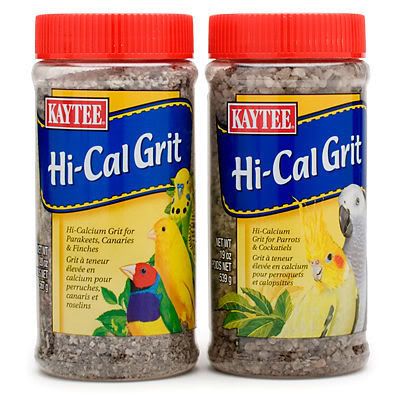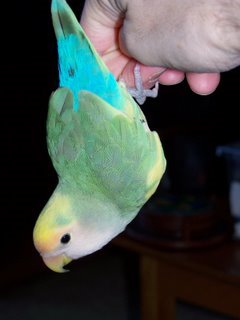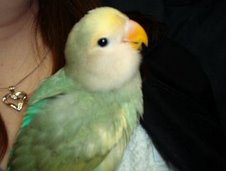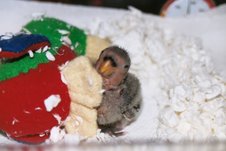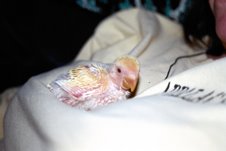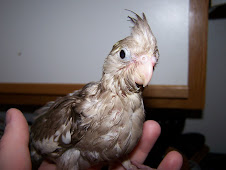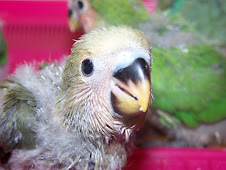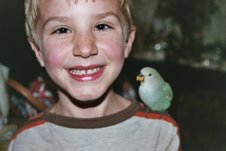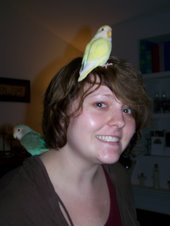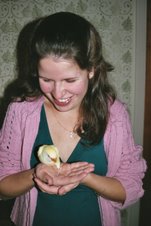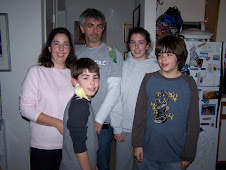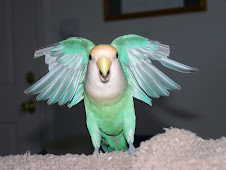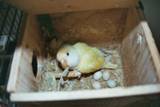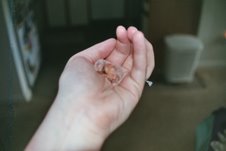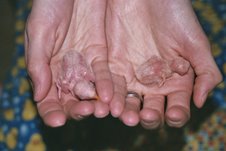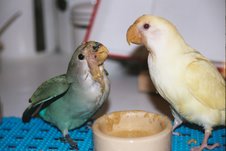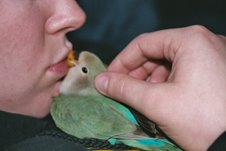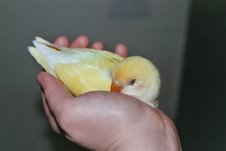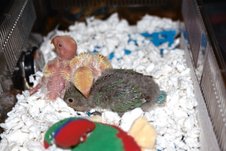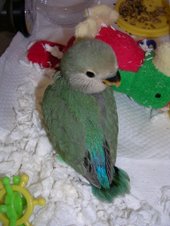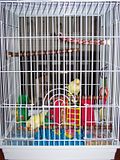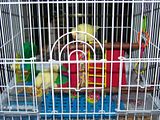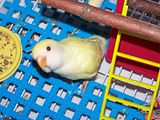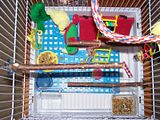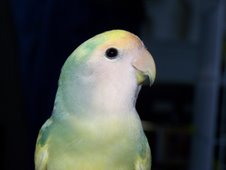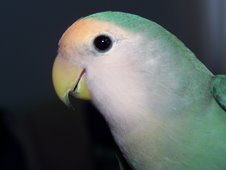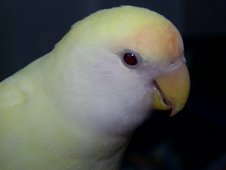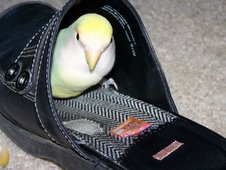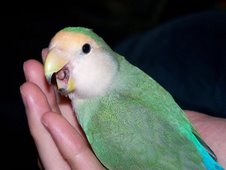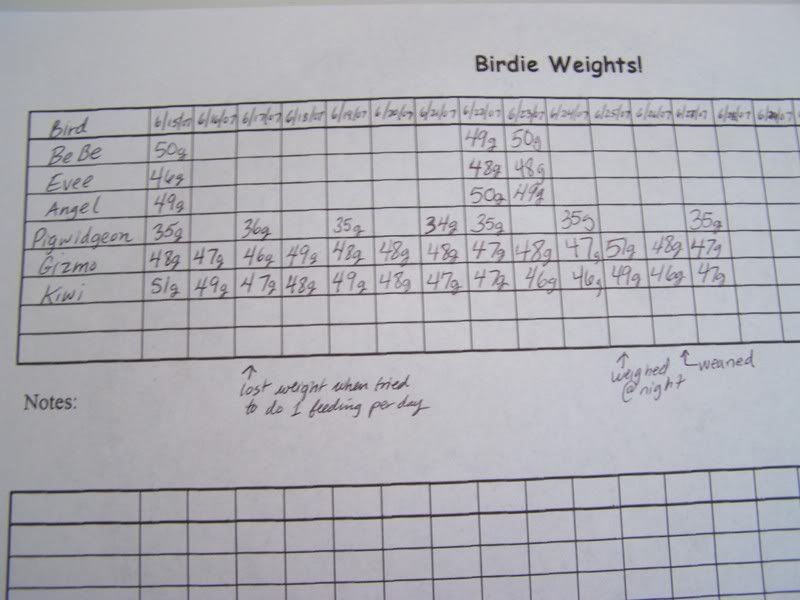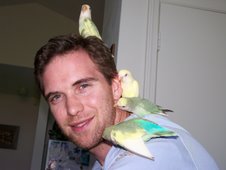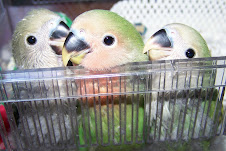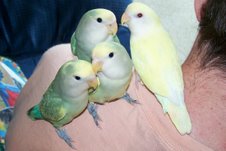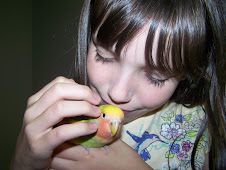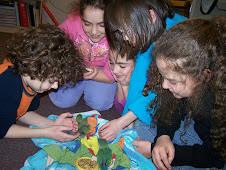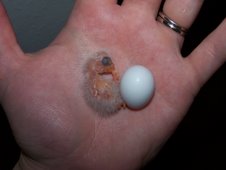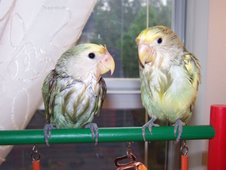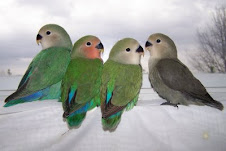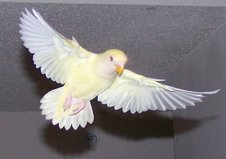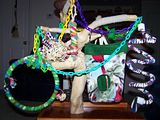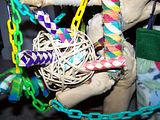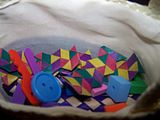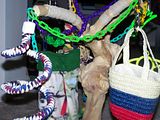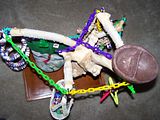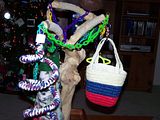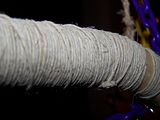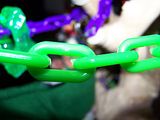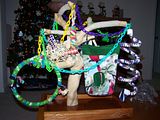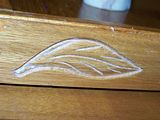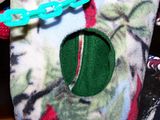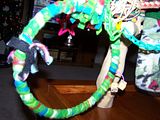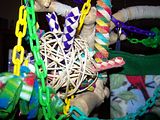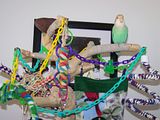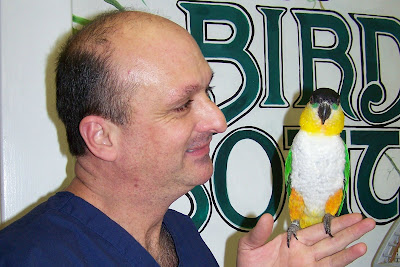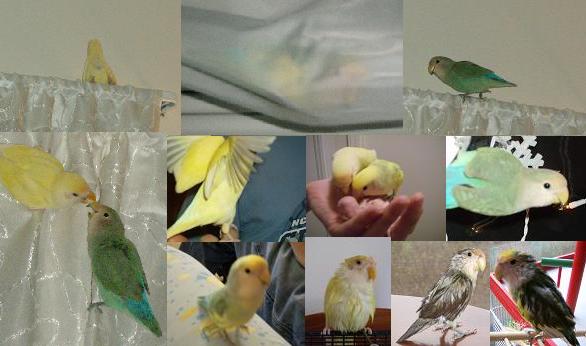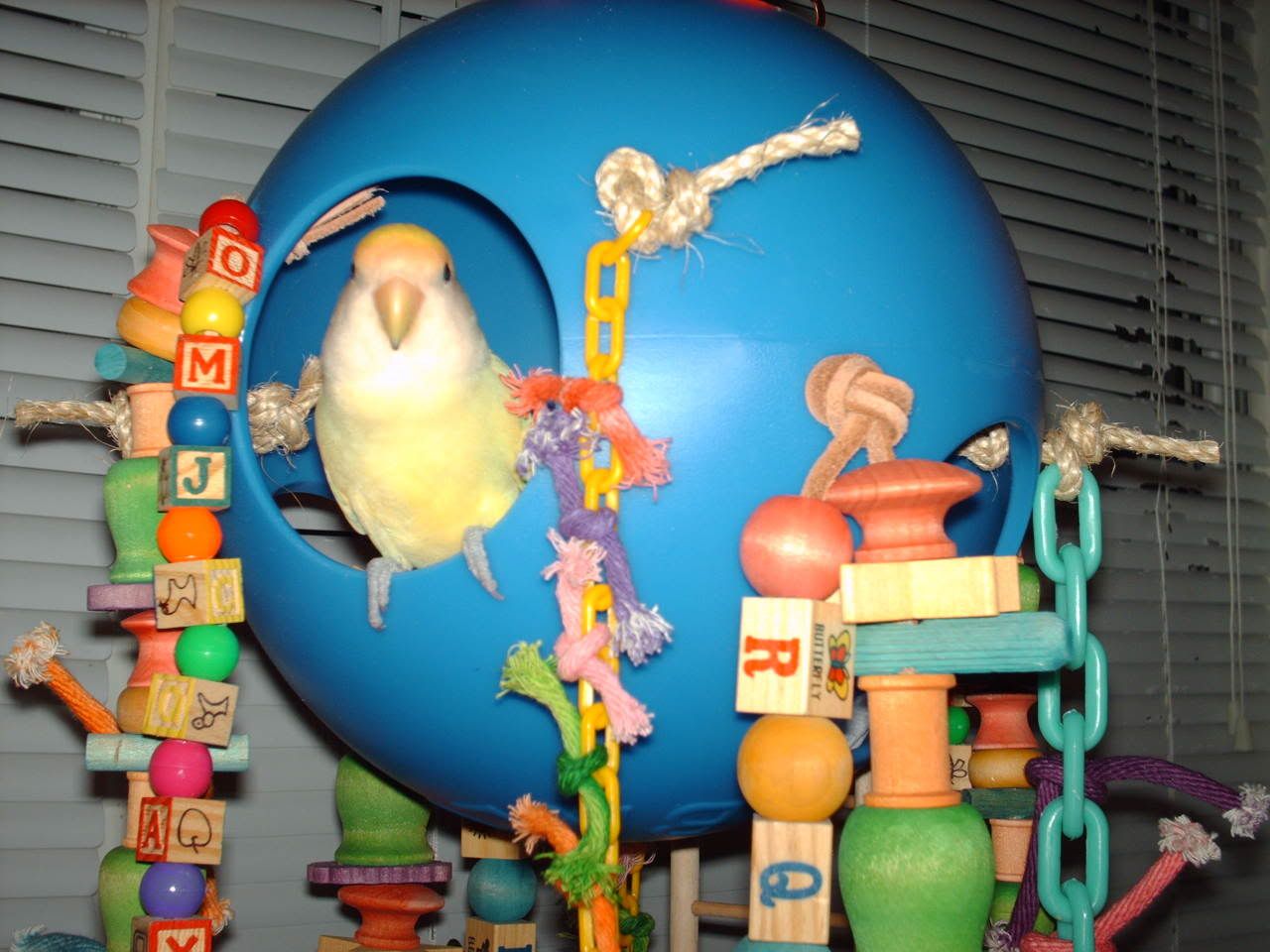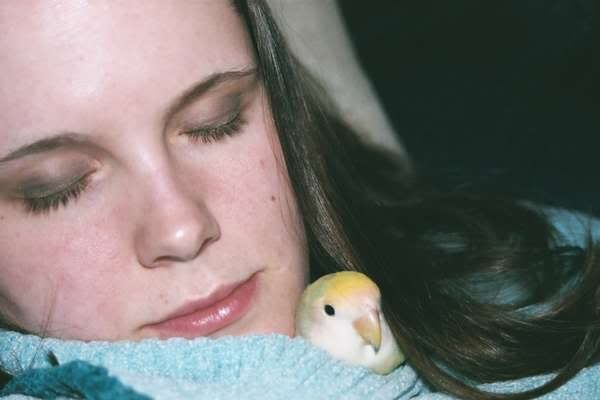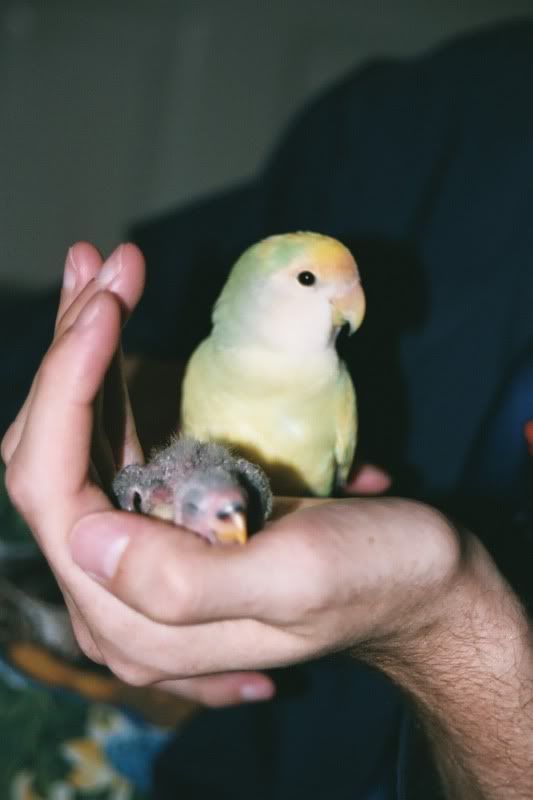Welcome!!!
We are the owners of an awesome E-Bird store (stuff for all birds of all sizes!) and Lovebird Aviary in Cary, NC. Our birds are quite popular because of their temperaments and socialization. Our dear Angel passed away on July 30th, 2007 and we lost our Evee on September 11, 2013. We have retired from breeding but are advocates of fostering and adoption!
True Love Aviary's Family
Highlights from 2005-2009
Availability:
Our Birdroom!
BeBe's Set-up for 1 Lovebird!
1 Cockatiel or 2 Lovebird Set-up
Parakeet or Budgie Set-up
Amazon Parrot Set-up
About our lovebirds:
Tuesday, April 28, 2009
Saturday, April 11, 2009
Video: Bird Bath Time
Here's our little ones enjoying a bath. The windows have screens to let in the sun so the birds will produce vitamin D3. And no, the "scary wind" is not going to make them sick. If that was so then you would get sick every time you went to the beach or the pool. Birds were made for the outside.
Posted by
Tamara
at
7:33 PM
2
comments
![]()
Labels: Video, Vitamin D3
Friday, April 10, 2009
New Toys: "Extreme Playtime!"
Thursday, April 9, 2009
Wednesday, April 8, 2009
Tootsie Bath Time
Posted by
Tamara
at
6:26 AM
2
comments
![]()
Labels: Bath, seagreen slate, Slate, Tootsie
Tuesday, April 7, 2009
"Warning to All Who Dares Enter TLA!!!"
 "Cockatiels will control your mind!"
"Cockatiels will control your mind!" "You will end up in the loony bin!"
"You will end up in the loony bin!" "My friends, you have been warned!" (Insert evil laugh here: "BWAHAH!")
"My friends, you have been warned!" (Insert evil laugh here: "BWAHAH!")Monday, April 6, 2009
The Birdies' New Toys Came In!!!!!
 Our birdies just received their brand new toys from Dr. Burkett! Guess which one was their favorite?
Our birdies just received their brand new toys from Dr. Burkett! Guess which one was their favorite?
Posted by
Tamara
at
6:26 AM
2
comments
![]()
Sunday, April 5, 2009
Some Birdies at the RDCBS March Meeting
Posted by
Tamara
at
5:57 PM
2
comments
![]()
Labels: African Grey, conure, Macaw, RDCBS, Skittles, Tootsie
Friday, April 3, 2009
Update: Jelly Bean and Starbuck (aka Pixy)
They both are doing very well and are a total joy to have. They are so funny!
Posted by
Tamara
at
9:21 AM
0
comments
![]()
Labels: Creamino, Dutch Blue, Jelly Bean, Pixy, starbuck, Update
Thursday, April 2, 2009
RDCBS Article on Caiques
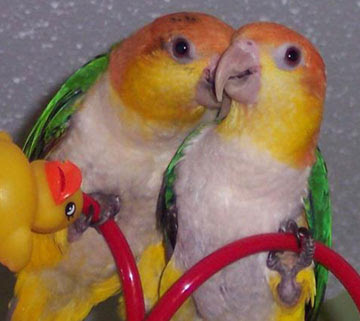 Photo from caiquesarepeopletoo.homestead.com (Trouper and Ripley)
Photo from caiquesarepeopletoo.homestead.com (Trouper and Ripley)
Caiques
By Rodney Money
trueloveaviary@gmail.com
Tamara: “Are you sure we are going the right way?”
Rodney: “Yes, I actually looked up the directions this time, plus, I MapQuested it.”
Tamara: “Hey! Is that it?”
Rodney: “Well, telling by the parrots on the sign that says “Birdie Boutique” in front of the house, I would say so.”
Tamara: “Smart butt.”
Rodney: “Yeah, I know. (LOL.)”
This was the conversation Tamara and I had on our very first adventure to the Birdie Boutique in Durham, NC. We were engaged, broke, and without jobs. I was doing my student teaching for music at Apex High School, and because I knew birds would be in our life after marriage, I was looking for the perfect opportunity to immerse Tamara into the world of bird ownership. The moment we walked across the threshold, the sights and sounds of continents from all around the world resounded in our ears. Cockatoos, cockatiels, and budgies originally from Australia, African greys and Lovebirds with their roots in Africa, and from the New World: macaws, conures, amazons, and a very outgoing Maximilian’s Pionus that thought I was her Daddy. I can still feel those sharp, baby claws on my hand refusing to let go to this day.
We were excited to see that the Birdie Boutique had an open play area that allowed guests to play and help in the socialization of their birds. On the playground, our eyes caught the flashes and hues of emerald greens, tangerine oranges blended with shimmering yellows, and white as the pure, driven snow constantly in motion. As we got closer we saw that it was not just one parrot, but actually two very playful, acrobatic clowns working as one as they manipulated a toy made of wood and leather. We placed our hands near them not meaning to interrupt their play, but as soon as they saw us a new game has just begun; and Tamara and I were the main attraction.
“What kind of birds are these?” Tamara asked.
“Caiques,” I said as Tamara still looked puzzled.
“Pronounce that again, ‘Sweets,’” asked Tamara once again.
“(Ky-EEK’s) my ‘Love,’” I explained.
“Very cool, and so sweet and playful,” she said as she was already plotting on how to take them home.
In disappointment, due to our current status, I explained to her, “Right birds, wrong timing.”
“One day we will have birdies,” I thought, “one day soon.”
Every time I think of caiques I think of my very first meeting and lecture at the Raleigh-Durham Cage Bird Society. With pen and paper in hand, I was trying to digest every word concerning the topic of Nutrition for Our Birds, but in that instant a caique decided to initiate me into the club. As I took notes in my journal, he was wondering why the human got to play with all the cool toys. So he jumped on my lap, grabbed the leather binding holding together all my papers, and proceeded to dismember them. While I willingly gave up my journal to my new friend, more like to his beak, I signaled to his owner that it was completely all right. I was deeply honored that he decided to spend his time with me destroying my personal belongings. Because the caique welcomed me that day, I have been back to the meetings ever since.
Because of their playful, inquisitive, and “always on the go” attitudes, caiques have been called the closest thing to New World Lories. These little, animated clowns are also the parrot version of the hopping kangaroo; often preferring hopping and climbing over flying. They develop extremely strong feet and can be especially obsessed with foot toys. Although their diet consists more of a parrot diet, their high energy levels can rival that of a lory or lorikeet. Just like a young puppy, a caique loves to wrestle and roll a round on their back with their toys, owners, and even other birds. This rough-and-tumble play often surprises people when they catch their caiques wrestling on the bottom of their cages just like two Jack Russell Terriers. Watching them play can be more entertaining than going to the movies.
Caiques that are kept in pairs often act like siblings. If there is a dispute over a toy, treat, or a favorite perch, they will normally make-up and are back being friends in no time. In fact, caiques are known to remain tame even if they have a cage mate as long as there is daily playtime and proper socialization from their owners. Even with all this energy, they share a characteristic often found in the play of Lovebirds. They play hard, but eventually they crash, falling asleep like little babies. Owners have found this to be the perfect time for cuddles, snuggles, and the ever popular head rub. Caiques have even been known to sleep on their backs scaring some owners half to death only to realize that their baby was just acting silly.
These South American little wind-up toys are considered to be a medium sized parrot with a length of 9 inches and weighing somewhere between 170 to 190 grams. They are good as a single pet, but more entertaining in pairs, and do quite well living in apartments. However, some individual birds can have a harsh shrill resembling a whistle. The two main species most commonly found in captivity are the White-bellied Pionites leucogaster and the Black-headed caique Pionites melanocephala. The White-bellied caique we see mostly in the USA is the Yellow-thighed caique Pionites leucogaster xanthomeria. This subspecies has obviously yellow thighs in compared to the nominate race that has green thighs. The Yellow-thighed caique is often referred to as a White-bellied caique. The White-bellied caique is reported to be a bit calmer than the Black-headed caique and a little less high-strung, but calmer and less high-strung is a relative term when taking about the exuberant personality of the caique. With good care, a caique can live more than 20 years in captivity.
Caiques can become stubborn and may get out of control if they get too excited. Many of a parrot enthusiast has reported that the worst bite that they have ever received came not from a macaw or a cockatoo, but from a caique. These mischievous rascals tend not to be shy around strangers, especially if they are seduced by toys or treats, but people need to always stay a step ahead of these intelligent birds. A caique’s temperament has been compared to that of a Scarlet Macaw. Some caiques have been known to be very sweet when picked up, but bite fiercely out of deviance when being put down. Also, caution should be used when introducing a caique to new clothing, hair style, or flashy jewelry. The same bird who seems fearless and could take on the world one second, could suddenly exhibit extreme fear over an inanimate object. Caiques tend to be gregarious amongst their own kind, but can be aggressive when introduced to lesser dominating species. However, I know of at least one household that is not run by the caique, but by a Pacific parrotlet.
Caiques have healthy appetites and can go through a bowl of food in minutes. So an owner needs to make sure that their caique is not losing weight due to not enough food in comparison to their high level of activity. Most caiques love water and are prone to frequent baths even after just receiving a bath. Like conures, caiques benefit from having a tub in which they can bathe, and some even relish “leaf bathing” just like budgies. For one caique a cage measuring 23” wide by 32” long by 64” in height is the absolute minimum with the bar spacing of 5/8” to 3/4”. Larger is always better, and playgrounds outside the cage are a necessity. With a playground, toys, and foraging opportunities, caiques can be very self-entertaining avoiding driving their owners crazy with constant, demanding attention. Caiques are always on the move and tend to use their owners like a moving playground instead of a perch.
Because of their high intelligence, trick training is a great way to keep the mind of a caique busy. Plus, it is easy to entice them because of their love of treats. Some of the most extreme tricks are inspired by play. One example is when owners spin their caiques round and round on a string or piece of leather while they’re just holding on by their feet. This is truly a hilarious sight especially when you hear actual laughter coming from the bird. Black-headed caique Elvis, the mascot of the Birdie Boutique and the coolest caique of all, loves performing this signature trick in front of a live audience every chance he gets. Other favorite tricks of caiques include: playing dead,
shooting basketball through a hoop, retrieving objects, any trick that highlights their love of hopping either up and down or from one place to another, and mimicking different words or sounds. Even though caiques are not known for their talking ability, some can learn a few words. Caiques are better imitating sounds of objects found within the home. Like African greys, owners have to make sure that their caiques don’t pick up annoying habits like imitating an alarm clock or the beeping of a smoke detector.
Even though caiques are high energy birds, they tend to do very well in calm and peaceful households. They act as though they are feathered sponges saturated by the peace that surrounds them. With their white, little bellies and their bright shining, often devious and cunning eyes, a caique will always stand out in a flock of other birds. And when onlookers observe people wearing sweaters ornamented with holes and tears, these patient and forgiving owners will always proclaim when asked the question of ownership, “Yes, I have a caique.”
Posted by
Tamara
at
10:49 PM
0
comments
![]()
Dewey & Sierra
Our Breeders: Creamino x Dutch Blue Pied Peach-Faced Lovebirds
The Next Generation....
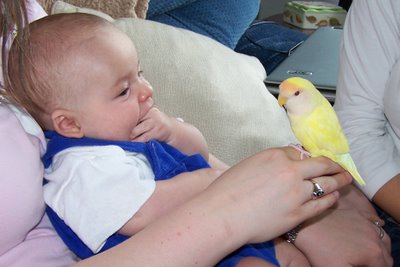
Of Bird Lovers!
Size Comparison
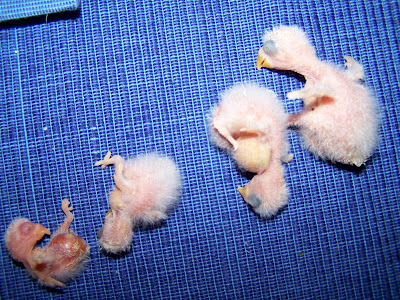
Each are 2 days apart (Youngest to Oldest: Left to Right)
Where People Get Their "Pet" Birds
Here are the options in the USA where people get their pet birds. I did not include shelters and second hand opportunities though; just where you would be more likely to find a parent-raised or handfed baby. Also, I will explain their level of tameness of the birds, care, the knowledge of the people who either work or run the establishments, and any other thing I can think of.
1. Large, retail petstore chains: (ex. Petsmart, Petco, Pet Supermarket, and other franchises, etc.)
This is the absolute worst place you could find a bird to call your own. Both Petsmart and Petco get their birds from the Kaytee Preferred Birds program which has two facilities located in Florida. They are also establishing one in Las Vegas. Of the two in Florida, one handles parent-raised small birds such as finches, budgies, and lovebirds which they buy from various mass production breeders, and one that mass produces larger parrot species for intention of handfeeding. All the breeders and babies are fed a medicated diet that includes vitamins and minerals, as well as antibiotics including Doxycycline for bacteria growth. The great use of these antibiotics will weaken the immune system and make the future successful use of antibiotics questionable. Kaytee does not care about the emotional development of their birds since they already have a contract with Petsmart and Petco stating they need to produce a quantity of chicks and not a quality of chicks to keep up with the high demand of sales. All the birds are shipped from Florida or Las Vegas, so you might as well be buying a wild-caught bird from Africa, Central and South America, or Australia. These birds are then quarantined for three days or put out on the floor when stock gets low. The stock room where the birds are quaranteed is a poorly lit dungeon only having human contact during feeding and cleaning. When at the store the birds are fed a very poor seed diet which leads to fatty liver disease and death (so with their weak immune systems, the stress of being shipped, and fatty liver disease, people wonder why their parakeet from Petsmart died in just a week?) The birds when placed out on the floor, especially the smaller birds, are cluttered together in cages with improper food, perches, and little to no toys. The so-called "experts" are usually teenagers in High School or college who could not tell the difference between a cockatoo and a macaw. The only time the birds are handled is if a customer is interested, because the employees and their employers do not want to risk damaging their merchandise. Handfed babies are fed Kaytee Exact Handfeeding formula which is hard to digest in the bird's crop. Employees and Employers are not worried about socialization of the babies; their only concern is to feed them as quickly as possible so they can bag up more fish, the true highest profitable merchandise, for customers. The only way to stop this travesty of mass production of chicks is education to the public to stop buying birds at retail pet centers.
2. Local Small Business-owned Pet Stores:
The knowledge of the staff varies greatly depending on the expertise of its people. Even with a very knowledgeable and educated staff, it is near to impossible to socialize each and every bird and care for their emotional needs. Employers and Employees have their minds preoccupied with cleaning cages, feeding birds, stocking, handling accounts, and simply dealing with customers; because first and foremost, it is a business. Many pet stores handfeed their own babies, but even the best bird stores forget that they need to continue socialization and establish a constant routine of playtime after they wean. Pet stores is where I see the vast majority of sweet, handfed babies turn wild after weaning.
3. Large-scaled Breeders:
Very similar to the suppliers of babies to the large retail pet chains. Large-scaled breeders mass produce large amount of babies for profit. So unless they have a staff that dedicates their entire time to feeding, playing, and socialization, the emotional needs just can not be met simply due to the sheer numbers of birds. These breeders are contracted to pet stores, other breeders for future stock, and other clients to provide a quantity of birds for future or present profit. Not all large-scaled breeders have inhumane practices. Steve Hartman of Hartman Aviaries and Gail Worth of Aves International not only care about their babies, but also the wellbeing of their parents also. Large-scale breeders also have the means to establish breeding stocks that could develop the possible domestication of parrots through line breeding. Also, mutations and other genetic changes could be studied in a more controlled environment.
4. Small-scaled Breeders (like us):
Many of these breeders are hobbyists, though some can make a living and breed for profit. These breeders tend to have a intimate relationship with each baby that they raise. This intimacy could lead in studies of developing co-parenting. Personally, I believe that this is the best place to find a new, loving feathered family member as long as the breeders breed in a moral way with not only thinking of the wellbeing of their babies, but also their parents. Small-scaled breeders tend to keep their pairs within their homes unlike large-scaled breeders who breed in either large flight aviaries or warehouses.
Our Lovebird Babies!
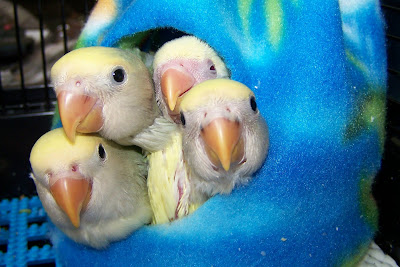
Cute, Tame, Playful, Well-socialized!
Pepsi or Coke?
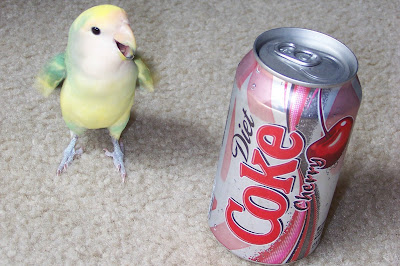
I guess Pepsi, or not Diet!
Things We Have Learned as Birdie Parents:
Toys, Playgrounds, and Foraging for Parrots
1. Destructible toys that appeal to a parrot’s instinct to chew. These toys include: branches with bark, finger traps, bird candy, milled wood, chipped wood, straw, cholla, cork, leather, paper, jute, hemp, weaved palm leaves, etc.
2. Sound-related toys for the instinct to communicate. These toys include: bells, stainless-steel or nickel-plated liberty bells, metal pipe bells, plastic pipe bells, rattles, and clackers, bird music boxes, sound-repeating devices, and any toy with resonating properties from plastic, paper, or metal cups.
3. Interactive toys for the bird’s intelligence or emotional needs. These toys include: beads, puzzle toys, foraging toys, snuggling or comfort toys, hiding or peeking-out toys, surrogate enemy toys, foot toys, and mirrors.
4. Exercise toys for physical activity. These toys include: swings, appropriate perches, platforms, playgrounds or trees, and boings.

Foraging is simply the act of finding food. Very simple in definition, but great in the impact it can have on the lives of our birds. Having our parrots work for their food is one of the best stimulations that we can provide. It does not matter if you have a budgie, lovebird, amazon, or a macaw, behavior problems will diminish if a parrot has the opportunity to forage for their food rather than eating straight from a bowl. In the wild, a parrot will occupy 60%-80% of their time searching for food. During their mission, a parrot will fly, use problem-solving skills, and manipulate their environment to find that prized morsel. This is a very heart-wrenching revelation considering our parrots, according to recent scientific studies, on the average spend only 15 minutes eating from their bowls and the rest of their time waiting for us in their cage for eight hours while we are working. Our beloved birds want more and deserve more. Our feathered friends have provided richness, stimulation, beauty, and love in our lives; should we not also provide them with anything less? A parrot needs to work for their food to stimulate both body and mind; their health will reap from the benefits also. Providing foraging opportunities is more work on our part, but the rewards are far greater with the antagonists of our selfishness. As our Avian Veterinarian Dr. Burkett states, “We put them in cages, the least we can do is provide the absolute best for them.”
5. Foraging opportunities for parrots include, but are not limited to, the following: natural foods and treats such as nuts, Nutri-Berries or Avicakes; foraging toys made specifically for birds; shredded paper, paper towels, or toys in a food bowl; supervised foraging on a playgrounds, trees, toy boxes, or baskets; hiding treats wrapped in carrot leaves or dark leafy vegetables, placing food in pinecones or stuffed in children’s toys such as a small dartboard from the local dollar store; taking treats and arranging them in the cage in a sheskabob; shreddable cardboard boxes with hidden treats; wrapping treats in paper and hanging them inside the cage, perch, or playground; placing food bowls in different locations in the cage providing several feeding stations. Wrap food in paper, paper towels, or paper bags and place in some stations while leaving others empty. Then, tape the top of the feeding stations with paper, or a destructible toy, so your parrot will first have to punch through the barrier and then remove the wrapped morsel; placing food in the holes of a cholla perch or destructible toys such as finger traps; hiding food in bird safe, untreated pine toys or cardboard boxes found in a craft store; foraging trays with hidden food and toys placed on the bottom or top of cages, playgrounds, or trees; having your parrot climb a branch, rope, or chain to his food, having your parrot lift a bucket or string to retrieve his food; sticking food in plastic waffle balls, teach flight training and retrieving, and my favorite: either hiding food in your clothes, making a birdie edible necklace, or holding your parrot’s food up high so he has to climb up you to receive his treat and the rewarding positive stimulation of his favorite sound, your voice.
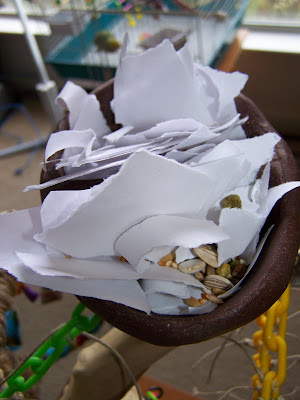
As you can see, foraging is only limited to the creativity of your mind. It always “cracks me up” when my lovebirds get so excited even when they just find some pellets buried under a mass of shredded paper towels. It will take you a few extra minutes a day to set up foraging opportunities and stations, but the rewards, positive stimulation, and environmental richness will last a lifetime in the lives of your beloved birds.
~Rodney Money
If you would like to use this article, just quote us as the source! That goes for any of our articles on here!
Bird Protectors
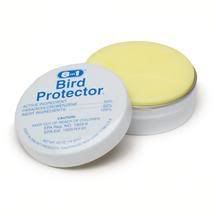
Chances are that at least once you have been browsing through the bird section of your favorite pet store and come across a product called a "Mite Protector". You may have wondered whether or not you need this product, and if it can really be beneficial to your pet's health.
A mite is a very small parasite that can infest the skin and feathers of most animal species. Truth be told, the vast majority of birds that were captive bred and have been housed in sanitary environments never experience a problem with mites or any other external parasites.
The "Mite Protectors" are usually small disc shaped containers designed to hang on the side of a bird's cage. The discs contain chemicals that release a fume to ward off mites, fleas, and other parasites -- but the fumes can potentially be harmful to the very thing you are trying to protect: your bird!
Birds have very sensitive and specialized respiratory systems, and the fumes given off by these Mite Protectors can be harmful or even fatal to them.
If you fear that your bird is experiencing a problem with mites or any other sort of parasite, the best thing to do is to schedule an appointment with an avian vet as soon as possible. Keep your pet healthy and happy by forming a good relationship with your vet and doing plenty of research on the bird products you are interested in before you use them.
Source: The Truth About Mite Protectors
Takes after his Daddy
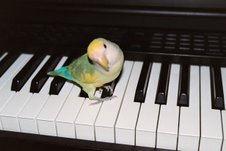
Making music in another way!
Featured:
Feeding Schedule and Socialization Goals
2 weeks old: 5 feedings every 4 hours (8:00am, 12:00pm, 4:00pm, 8:00pm, 12:00am.) Many other breeders only feed 4 times every 4 hours the first week, but we do not want the babies crying for food in the middle of the night. Just like human babies, there are small babies (Pixy!) and there are large babies (her brother Jelly Bean!), so the amount of food is going to vary around 3.5-4.5 cc’s. Tamara and I do not say, “Ok baby, you have had 4 ccs, your full!” No, we fill up the babies until their crops resemble a full balloon or when they simply do not want anymore. Feed the babies all at once; competition is your greatest ally. Well-socialization goal: babies should recognize you, have a wonderful feeding response, and have names.
3 weeks old: 4 feedings every 4 hours (8:00am, 12:00pm, 4:00pm, 8:00pm.) Just fill those crops until they look and feel like a full balloon. At 3.5 weeks old, the babies will start to chew on their bedding. This is the time to introduce “big bird” food. Fresh, chewy Avicakes are the perfect introduction to solid food. Avicakes are highly nutritious unlike seed or millet. After babies are fed baby food, place a very small crumb into their mouths. This works great as a birdie pacifier also. We never feed them mashed-up or soft foods for weaning. Starting them on what they will eat as adults is best. After they are eating “big bird” food, we introduce small foot toys and toys they can shred. Well-socialization goal: babies try “big bird” food, recognize your voice, and step-up on your palm to be fed.
4 weeks old: 3 feedings every 6 hours (8:00am, 2:00pm, 8:00pm.) We never drop their feedings to three until we know they are eating the Avicakes on a regular basis. This is the time when we introduce crushed-up Nutri-Berries and a small pellet like Roudybush Crumble. Depending on the size of the baby, they should be receiving around 6 ccs at this point. Once again, feel the crop and if the babies refuse, do not force them to eat. After we feed them baby food, we place them over the solid food bowl. This is the time we introduce a small dish of water also. Well-socialization goal: babies play with toys, eating adult food on a regular basis, and cry out not only for baby food, but for attention also. Some of the older babies at this point have a natural protective instinct of their siblings and territory, so to dilute this trait we lay down on the floor, cuddle, play with them with their toys, and feed them adult food by hand after each feeding. When they have fallen asleep, we place them back into the brooder.
6 weeks old: 1 feeding per day at 6:00pm or 8:00pm (babies can feed from 7-10 ccs at this point.) If we have a large clutch, 4 or more babies, the prodigies will normally wean during this week. Well-socialization goal: babies are filling up on adult food in the morning, babies want to come out of their weaning cage to fly, cuddle, and most importantly play with toys independently on a playground. Babies should never be on a person all the time when they are outside of their cages. They have to learn independent play and have foraging opportunities.
7 weeks old: A baby should wean at anytime now. If they do not cry for their evening feeding, then do not give it to them. At 7 weeks, we introduce cooked foods, fruits, sprouts, and veggies. The babies will see the adults eating the food and will follow their lead. Many breeders and pet stores separate their babies in individual cages so they will not bond with each other. This is one of the worst things they can do for a baby, especially one that has not weaned yet. Birds need that competition of the food bowl, thus learning to eat on their own and whenever food is presented. Lovebirds that also learn to compete for food will naturally compete for your attention also thus making trust issues virtually nonexistent. Well-socialization goal: the babies step-up from inside their cage, and the babies are excited to see you. Babies need a reason to want to come out of their cages such as a playground. That, plus routine, is the key to a well-socialize parrot and not one that is caged bound and only finds security in the confounds of their bars.
8 weeks old: Weaned. If you decide to clip, never clip a bird before they wean or they might not ever see a reason to get off the baby food. This is nature’s way: stop begging, get off Momma’s fat baby food, and fly! Even though socialization starts as early as two weeks, true socialization actually starts the week babies wean. Too many times we have seen and heard stories of birds that were handfed, but they turned wild. It happens during this week. The babies no longer need you as a source of food, so you need to show them that they still need you for other reasons: love, another source of fun, security, and socialization. During this week, most birds forgot you ever handfed them. All handfeeding does is that it gets a bird use to the presence of humans. So during the week your babies wean, the most important thing any of us can do is to continue a balance of training, positive reinforcement, cuddle time, and independent play. Why is a well-socialized parrot such an important goal? The simple answer is because they will live with people. If a bird is truly trust worthy, affectionate, and socialized, then chances are their humans will see them more than just birds in a cage, but as true family members. Thus, living a full and enrich life in a human household. Well-socialization goal: babies enjoy a great head rub and have first full vet check from an Avian Veterinarian.
~Rodney Money True Love Aviary







































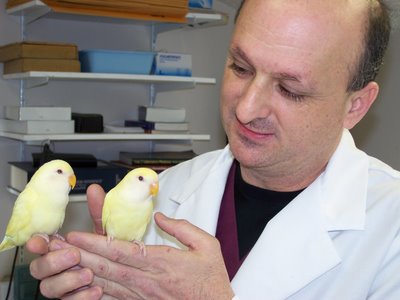
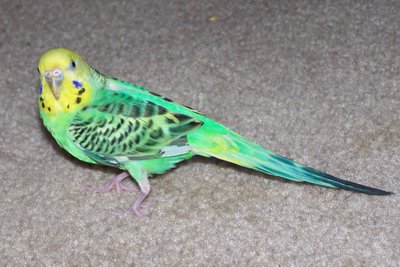
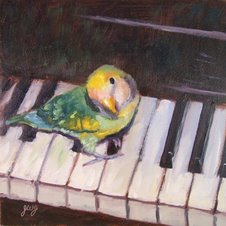
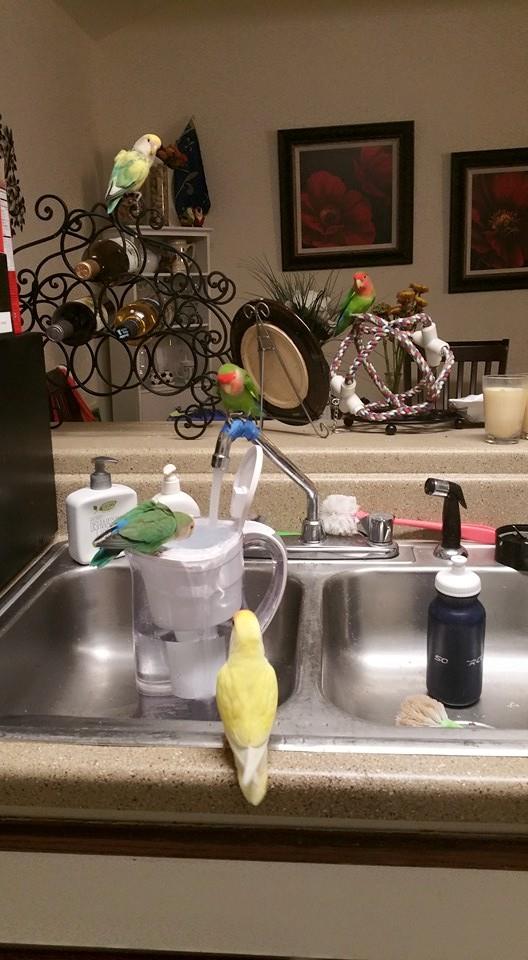




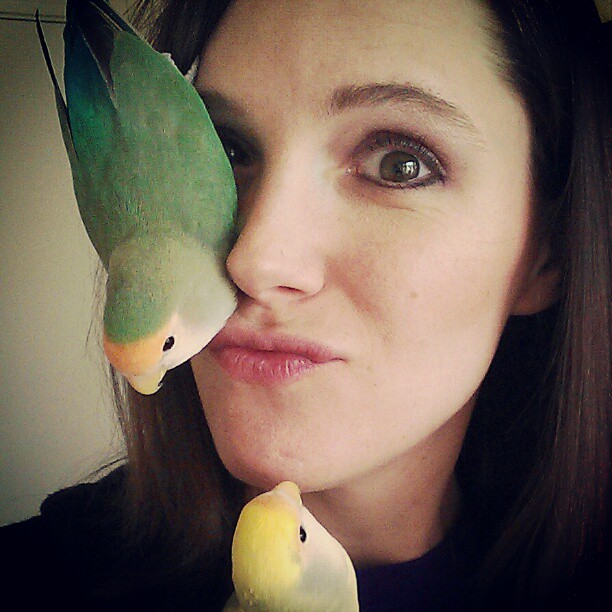 (919) 322-9334 (after 5pm EST, M-F; 10-2pm EST, Sat)
(919) 322-9334 (after 5pm EST, M-F; 10-2pm EST, Sat)
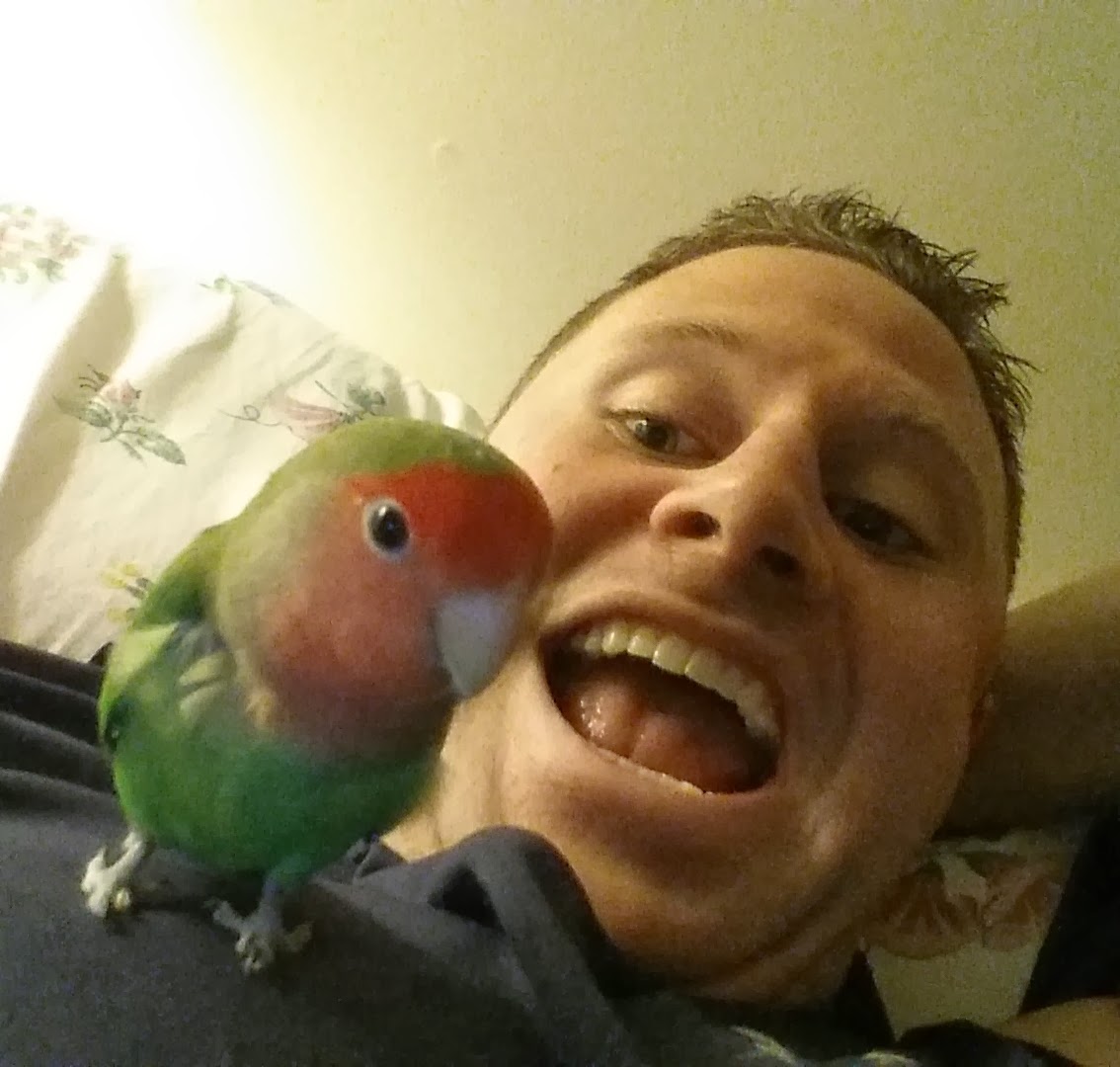



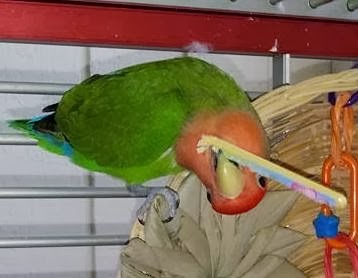
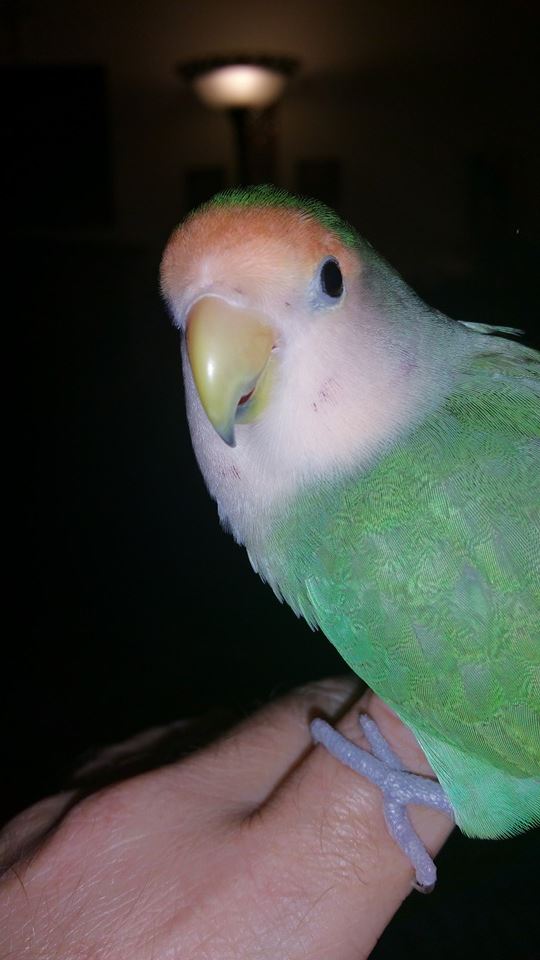





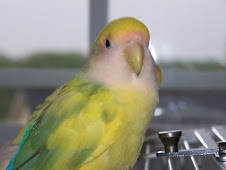
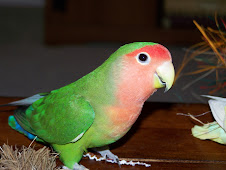
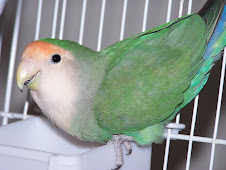
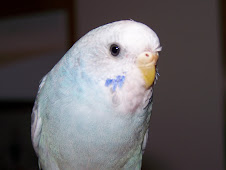
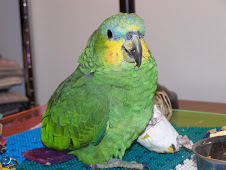
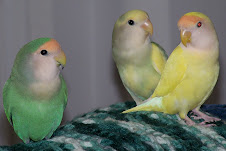
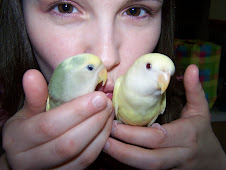
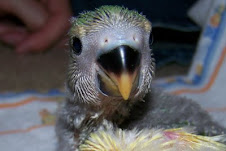
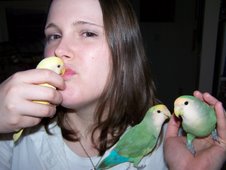
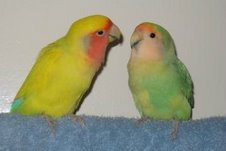
.jpg)
